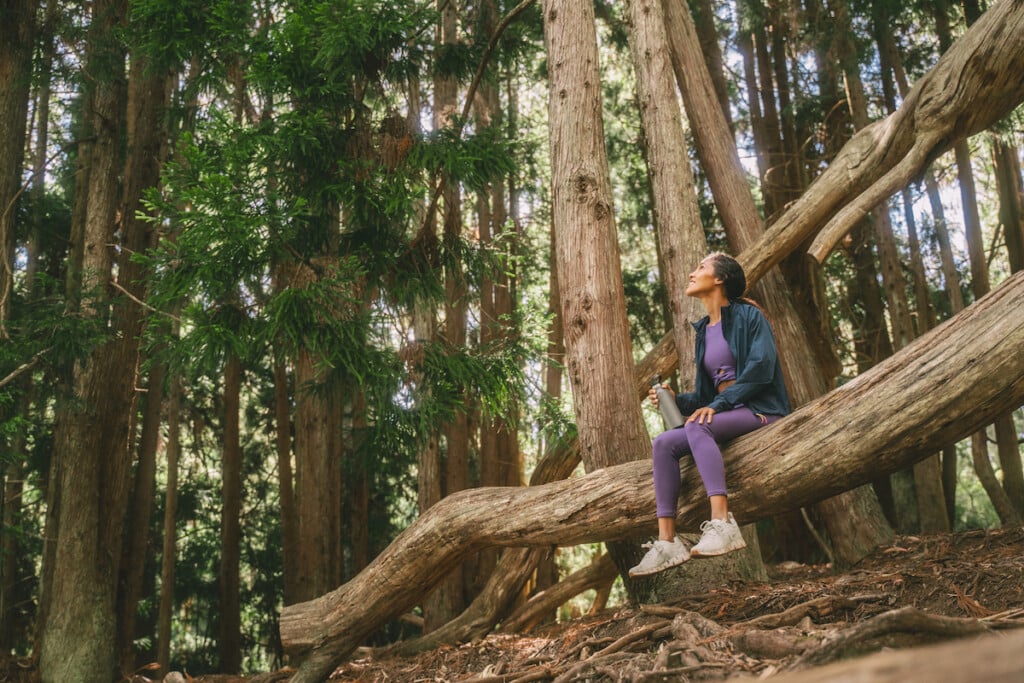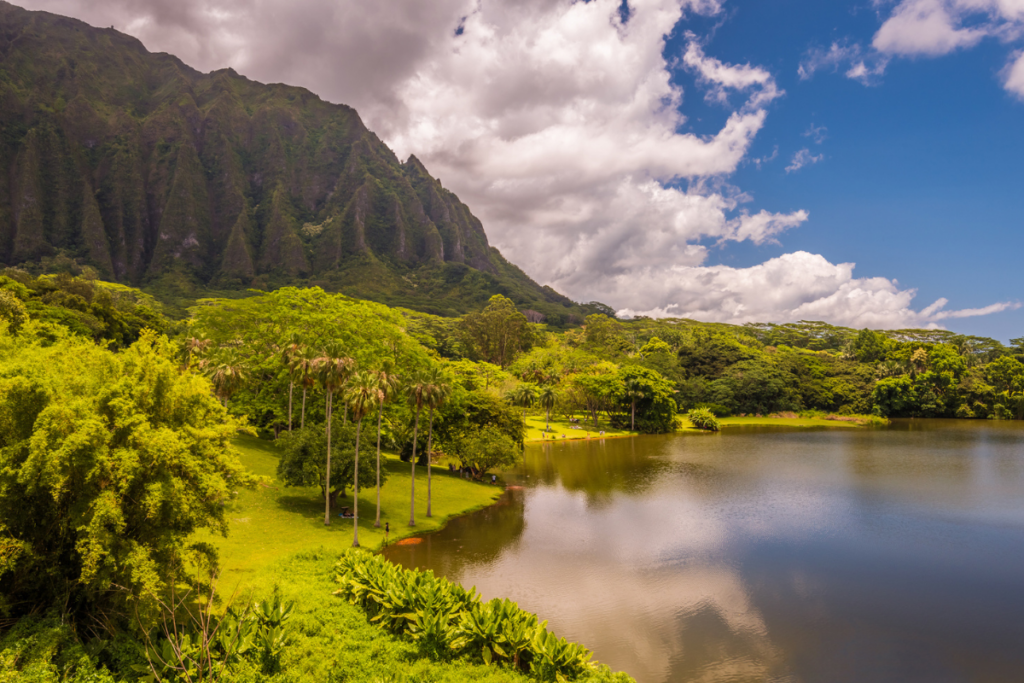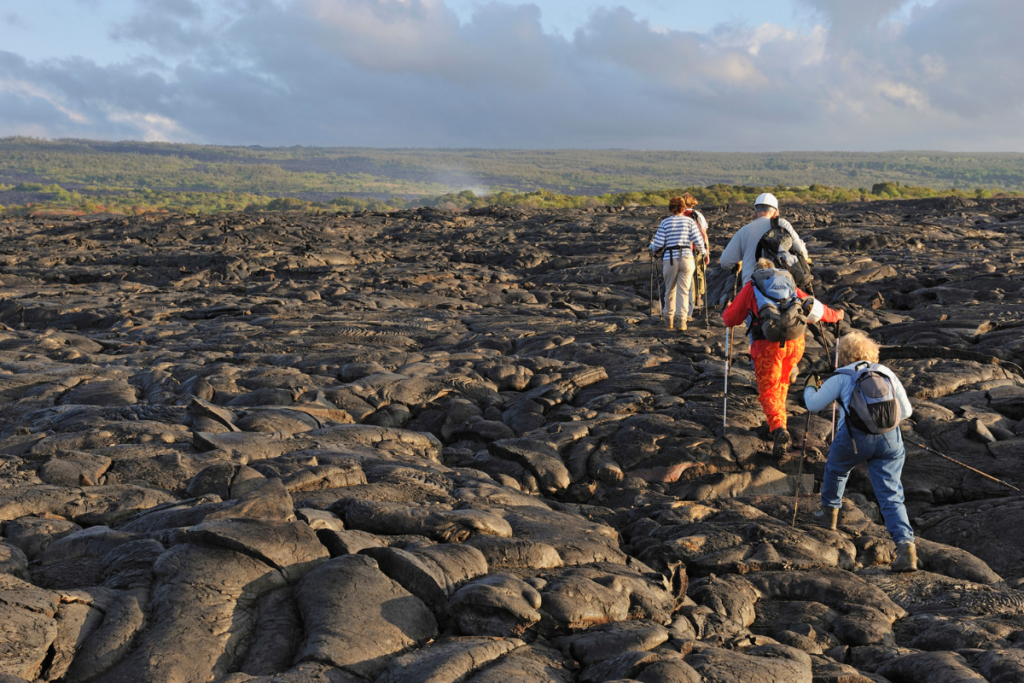9 Ways to Celebrate Earth Day in Hawaiʻi Every Day
There are so many ways to mālama (take care of) the Islands, even on vacation.

We should always be kind to the planet, but April 22 is Earth Day—officially the day we show special appreciation for our natural world. (It dates back to 1970, when Wisconsin Sen. Gaylord Nelson organized a national event aimed at raising awareness around important environmental issues.) And there’s a lot we can do, from volunteering at a beach clean-up to planting a native tree, even while we’re on vacation. Here are nine things you can do if you’re in the Islands today—or any day.
1. Take a Hike

Hikers walking along Puʻu ʻŌhiʻa Trail on Oʻahu.
Photo: Courtesy of the Hawaiʻi Tourism Authority/Heather Goodman
Getting outdoors is one of the easiest —and most enjoyable—ways to spend Earth Day. Hiking helps you appreciate the natural beauty of our planet. Hawaiʻi boasts dozens of hikes on every island, for every skill level. Venture along the rugged Molokaʻi coastline in the Momilani Preserve, walk across an old volcanic crater in Hawaiʻi Volcanoes National Park or trek to one of Maui’s many waterfalls. Bring a trash bag: Plogging—the combination of jogging and picking up litter—is a thing!
2. Plant a Native Tree

Volunteers planting native plants on Oʻahu.
Photo: Courtesy of the Hawaiʻi Tourism Authority/Heather Goodman
The classic Earth Day activity—planting trees. Not only do trees help decrease a city’s temperature (by up to 10 degrees), but they also absorb carbon dioxide, clean the air and, well, look pretty. In Hawaiʻi there are efforts to plant native trees, which add the benefit of providing critical habitats to some of the state’s most threatened and endangered animals. The Hawaiian Legacy Reforestation Initiative, for example, provides opportunities for people to plant important native trees like koa, ʻōhiʻa lehua and milo on both Hawaiʻi Island and Oʻahu.
3. Volunteer

Volunteers cleaning up a beach on Maui.
Photo: Courtesy of the Hawaiʻi Tourism Authority/Mathieu Duchier
Voluntourism is one of the biggest trends in tourism, where travelers participate in voluntary work in the community where they are vacationing. The state recently launched the Mālama Hawaiʻi Volunteer Dashboard that connects visitors to various nonprofits and community groups looking for volunteers. You can help restore an ancient Hawaiian fishpond, sort food donations at food banks or help at community events. There are also opportunities for visitors to help Maui in the wildfire recovery. (You can also donate money directly to nonprofits, too.) Volunteering not only helps the community, but you’ll feel good about it, too.
4. Ditch the Rental Car
Fewer cars on the road means less carbon emissions in the air—and that’s a good thing. On Oʻahu you can opt to catch the city bus, with routes all over the islands and to popular visitor attractions, or use Biki, Honolulu’s bike share program. You can rent bikes on most islands, too. On Kauaʻi, for example, you can ride along the Ke Ala Hele Makālae trail that hugs the island’s eastern coastline or book a downhill bike tour from Waimea Canyon to the ocean. It’s a great way to reduce your carbon footprint while enjoying Hawaiʻi’s beautiful scenery—and burn some calories in the process.
5. Observe Animals in the Wild

A humpback whale breaching off Lahaina on Maui.
Photo: Getty Images/Beth Cagnoni/500px
Gain a greater appreciation for Hawaiʻi’s unique wildlife by witnessing them in the wild. Right now should be able to still spot North Pacific humpback whales—these giant visitors spend winter in the Islands—on guided boat tours or from the shoreline. Or book a birding tour with Hawaiʻi Bird Tours to see some of the state’s most iconic birds, from endemic forest species like the Hawaiian honeycreepers to pelagics and endangered water birds like the nēnē (Hawaiian goose). Just remember: In Hawaiʻi, if you see a wild dolphin, monk seal or honu (Hawaiian green sea turtles), there are rules to how close you can be.
6. Use Reusable Bags

Use a reusable bag.
Photo: Getty Images/andresr
It’s been estimated that Americans use an average of 365 plastic bags per person per year, and just the production alone for plastic bags requires about 12 million barrels of oil. Add to that plastic bags fill up space in our landfills and cause problems for marine wildlife. Pack reusable bags with you or get one from a locally owned shop. Foodland Hawaiʻi, a locally owned grocery chain, has a bunch we like—big, sturdy, affordable and with fun, local designs.
7. Shop at a Farmers Market

Vendors at the Hilo Farmers Market on Hawaiʻi Island.
Photo: Aaron K. Yoshino
Every island has a farmers market—we like the ones organized by the Hawaiʻi Farm Bureau—where you can taste and buy local fruits, vegetables, jams, preserves, honey, chocolate and coffee, all in one place. Eating local is one of the best things you can do for the planet, too. Hawaiʻi imports about 85% of its food, and supporting local farmers, ranchers, fishermen and producers helps the state’s agricultural industry. Plus, spending a few hours at a local farmers market is fun way to explore and learn about the Islands. You can pick up artwork or jewelry made by local artisans or grab lunch packed with local ingredients. Many of these markets have entertainment, too.
8. Use Reef-Safe Sunscreen

Use reef-safe sunscreen.
Photo: Getty Images/swissmediavision
In 2018, Hawaiʻi passed a long-awaited bill that banned the sale of sunscreens that could harm Hawaiʻi’s coral reefs. (The law went into effect in 2021.) These reefs are diverse ecosystems that are incredibly delicate and susceptible to various threats like pollution, rising ocean temperatures and overfishing. It’s anticipated that by 2050, all coral reefs will be classified as “threatened.” Believe it or not, sunscreen is a culprit, with an estimated 14,000 tons of it getting into the ocean each year. The two main ingredients to avoid: oxybenzone and octinoxate. Look for sunscreen with labels that read “reef-safe” or “reef-friendly,” and check the ingredients. Some local brands to try are Little Hands Hawaiʻi and Ao Organics.
9. Shop Local

Shopping local in Hawaiʻi.
Photo: Getty Images/FatCamera
Besides helping the local economy and creating more jobs, supporting local businesses—wherever you are—is one way to reduce your carbon footprint. How? Transportation. A local business tends to make more local purchases, which requires less transportation. And that means less pollution. In addition, you don’t have to travel far to visit these businesses, and the item doesn’t need to be shipped to you. It’s as simple as that. Plus, you’ll have something unique to bring home from your Hawaiʻi vacation, made by a local artist, crafter or producer. It’s a purchase you can feel good about.



